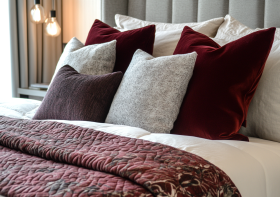Why Painting Your Doors the Same Color as Your Walls Works Wonders

In the world of interior design, continuity can play a crucial role in creating a harmonious environment. One lesser-known yet highly effective strategy is painting your doors the same shade as your walls. This simple design choice can transform the feel of a room, making it feel larger, more cohesive, and unquestionably chic. Here’s why this trend might just be the update your space needs.
Enhances Spatial Perception
Painting doors the same color as the walls can significantly alter the perception of space within a room. This technique minimizes visual interruptions, allowing the eye to travel smoothly around the room without the usual stop-and-start caused by contrasting trim colors. The result is a more expansive, open feel, even in smaller spaces.

Creates a Cohesive Aesthetic
Consistency in color between walls and doors enhances the overall aesthetic of a space by creating a seamless look. This unity helps to elevate the perceived value of your home by giving it a custom-designed appearance. It’s particularly effective in homes with an open floor plan, where it can help maintain a fluid feel across multiple connected areas.

Focuses Attention on Other Elements
With doors blending into the walls, decorative elements such as artwork, furniture, and architectural features can take center stage. This effect can be especially powerful in homes where bold art or statement furniture pieces are key features of the decor. It allows these elements to pop without competing with the basic structure of the space.

Simplifies Color Choices
Choosing paint colors can be daunting. By reducing the number of colors needed (no need to select a contrasting trim color), this strategy simplifies the decision-making process. It’s particularly useful for those who prefer a minimalist style or for anyone overwhelmed by the multitude of color choices available.

Offers Versatility
While this approach works exceptionally well with neutral colors, it’s equally striking with bold hues. Imagine a room in deep navy or a soft terracotta, with the monochrome extending from the walls to the door. This technique doesn’t limit color choices but rather amplifies the impact of any hue you select.

Enhances Modern and Minimalist Styles
For homes styled with a modern or minimalist aesthetic, continuing wall color onto doors can enhance clean lines and the uncluttered feel of the design. It’s a perfect match for the sleek, unobtrusive look that characterizes these styles, allowing for a smooth, uninterrupted flow throughout the living spaces.

Easy to Change
If you’re someone who likes to update your space regularly, painting the doors and walls the same color can be a practical choice. It’s easier to repaint a single color, whether you’re covering up wear and tear or opting for a completely new shade. This approach gives you the flexibility to refresh your decor without complex color matching.

Conceals Imperfections
This technique can also be used strategically to conceal imperfections. Doors that have seen better days or don’t have a particularly appealing design can be visually minimized by painting them the same as the walls, ensuring they don’t draw unwanted attention.

Whether you’re embarking on a major renovation or looking for a quick aesthetic upgrade, consider the sophisticated, unified look of matching your doors to your walls. This approach not only modernizes your space but also provides a unique, stylish simplicity that can make your home feel both larger and more inviting.
To deepen your understanding of crafting unique and personalized spaces, consider acquiring my book, Basics of interior design, available on Amazon. This guide offers a comprehensive exploration of various design principles tailored to distinct environments, providing you with the knowledge and inspiration needed to transform any space. If you want to learn more about the colors in Interior design, buy my book Color theory in interior design from Amazon.




